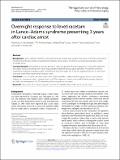Overnight response to levetiracetam in Lance–Adams syndrome presenting 3 years after cardiac arrest
Author(s)
AbdelRazek, Mahmoud A.; Marey, Ahmed; Taha, Ahmed; Morin, Scott J.; Brodski, Alexander; Mollashahi, Roohallah S.; ... Show more Show less
Download41983_2023_Article_721.pdf (606.6Kb)
Publisher with Creative Commons License
Publisher with Creative Commons License
Creative Commons Attribution
Terms of use
Metadata
Show full item recordAbstract
Abstract
Background
Lance–Adams syndrome (LAS), also known as chronic post-hypoxic myoclonus manifests as myoclonic movements of the face, limbs, or trunk following hypoxic brain injury, which may occur during respiratory failure or cardiac arrest.
Case presentation
We present a case and provide a video of a patient who developed LAS 3 years after experiencing cardiac arrest, presenting with action-induced generalized myoclonus upon standing. The patient exhibited a significant response to levetiracetam. To the best of our knowledge, this is the first reported case of LAS with such a delayed onset following the initial hypoxic event.
Conclusion
It is crucial for clinicians to be aware of this treatable condition and recognize that its onset may be delayed, occurring years after a hypoxic brain insult. This improved understanding will facilitate prompt diagnosis and effective management of LAS, ultimately enhancing patient outcomes.
Date issued
2023-08-24Department
Massachusetts Institute of Technology. Institute for Medical Engineering & SciencePublisher
Springer Berlin Heidelberg
Citation
The Egyptian Journal of Neurology, Psychiatry and Neurosurgery. 2023 Aug 24;59(1):120
Version: Final published version